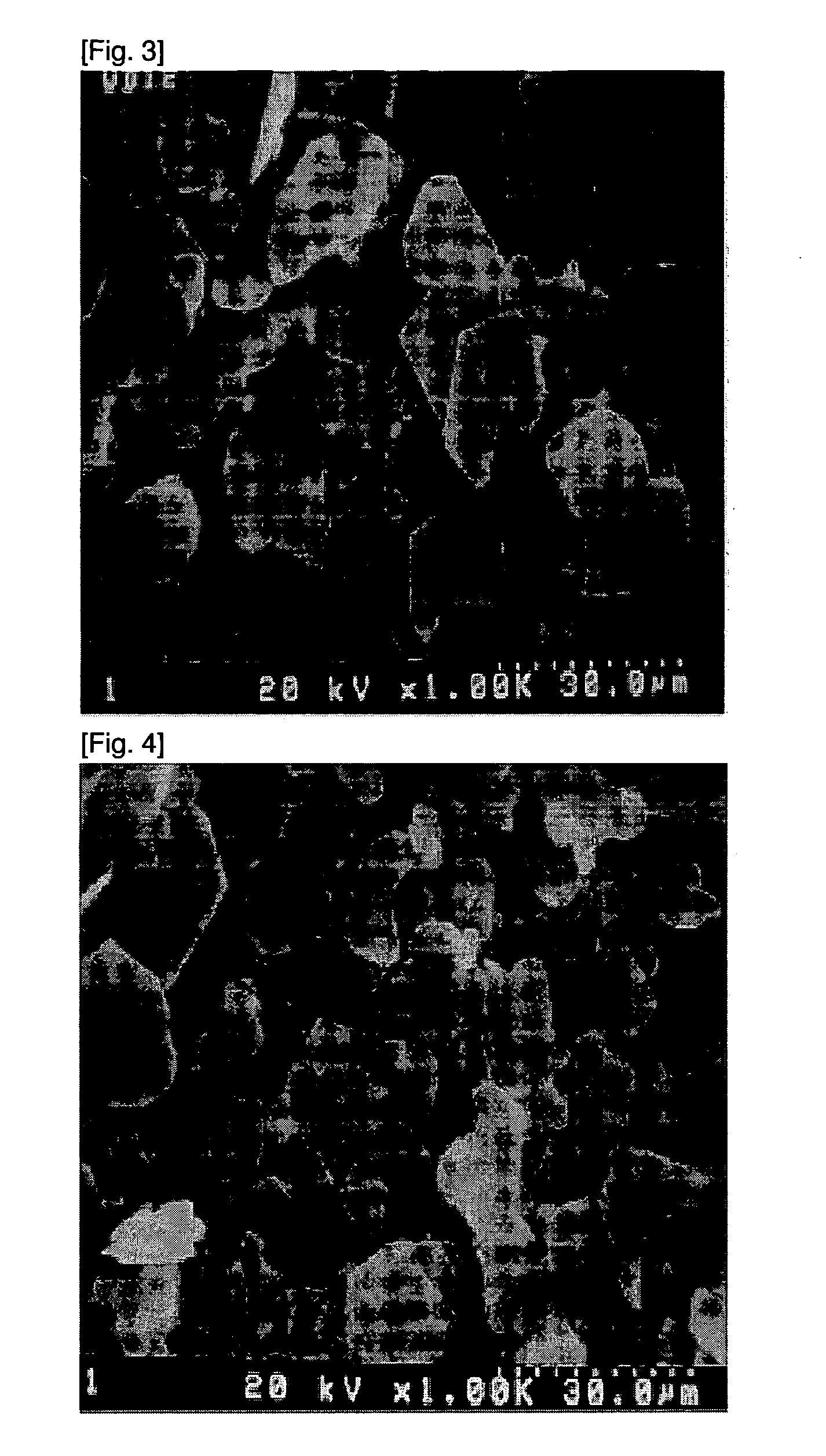Method of manufacturing flake aluminum oxide using microwave
a technology of aluminum oxide and manufacturing method, which is applied in the field of manufacturing flake aluminum oxide using a microwave, can solve the problems of high cost, high equipment cost, and the above-mentioned typical methods, and achieve the effects of improving product yield, reducing cost, and simplifying manufacturing methods
- Summary
- Abstract
- Description
- Claims
- Application Information
AI Technical Summary
Benefits of technology
Problems solved by technology
Method used
Image
Examples
embodiment 1
(1) Manufacture of Aluminum Hydroxide Powder
[0095]618.5 g of aluminum hydroxide powder (Showa Denko, Japan) having a size of about 10 to 53 μm, which is obtained by using a sieve having a mesh size of about 53 μm and a sieve having a mesh size of about 10 μm, is put into a highly purified alumina ball mill jar having a capacity of about 2.2 l, and 2,637 g of alumina ball having a diameter of about 7 mm is put into the alumina ball mill jar, and then the aluminum hydroxide powder was ball-milled at a speed of about 150 rpm for 6 hours. After that, the ball-milled powder is dried in a drier at a temperature of about 80° C. for 12 hours. As a result, it is possible to obtain aluminum hydroxide powder with an average particle size of about 1 to 20 μm which is a precursor of transition alumina.
(2) Manufacture of Transition Alumina
[0096]The aluminum hydroxide powder which is manufactured in step (1) is heated in a box-shaped electric furnace, to which a thermo regulator is attached, with ...
embodiment 2
(1) Heating for Crystal Growth
[0100]Aluminum hydroxide powder, transition alumina and dry powder are manufactured in the same manner performed in Embodiment 1 and the dry powder is heated in the same microwave heating device used in Embodiment 1 at a rate of 660° C. / hr in a temperature of about room temperature to 700° C.; at a rate of 300° C. / hr in a temperature of about 701 to 950° C. and here, the heat-treatment is held for 10 minutes and further the dry powder is heated again at a rate of 120° C. / hr in a temperature of about 951 to 1,200° C. and here, the heat-treatment is held for 60 minutes to change crystal to the flake α-aluminum and then the dry powder is cooled to room temperature under a natural condition. But here, there is an increase in the amount of the tin compound SnF4 to 0.025 mol which is added to improve a deposition property of the nanoparticle while manufacturing the dry powder in Embodiment 1.
(2) Manufacture of Flake Aluminum Oxide
[0101]The same process perfor...
embodiment 3
(1) Heating for Crystal Growth
[0102]Aluminum hydroxide powder, transition alumina and dry powder are manufactured in the same manner performed in Embodiment 1 and the dry powder is heated in the same microwave heating device used in Embodiment 1 under the same conditions as in Embodiment 1 to change crystal to the flake α-aluminum and then cooled to room temperature under a natural condition. Here, there is no addition of the tin compound SnF4 which is added to improve a deposition property of the nanoparticle while manufacturing the dry powder in Embodiment 1.
(2) Manufacture of Flake Aluminum Oxide
[0103]The same process performed in Embodiment 1 is performed on the synthesized ingredients in the crucible in step (1) such as separating the crystal, washing and drying. As a result, it is possible to obtain 97 g of white flake aluminum oxide.
PUM
| Property | Measurement | Unit |
|---|---|---|
| Temperature | aaaaa | aaaaa |
| Temperature | aaaaa | aaaaa |
| Temperature | aaaaa | aaaaa |
Abstract
Description
Claims
Application Information
 Login to View More
Login to View More - R&D
- Intellectual Property
- Life Sciences
- Materials
- Tech Scout
- Unparalleled Data Quality
- Higher Quality Content
- 60% Fewer Hallucinations
Browse by: Latest US Patents, China's latest patents, Technical Efficacy Thesaurus, Application Domain, Technology Topic, Popular Technical Reports.
© 2025 PatSnap. All rights reserved.Legal|Privacy policy|Modern Slavery Act Transparency Statement|Sitemap|About US| Contact US: help@patsnap.com



